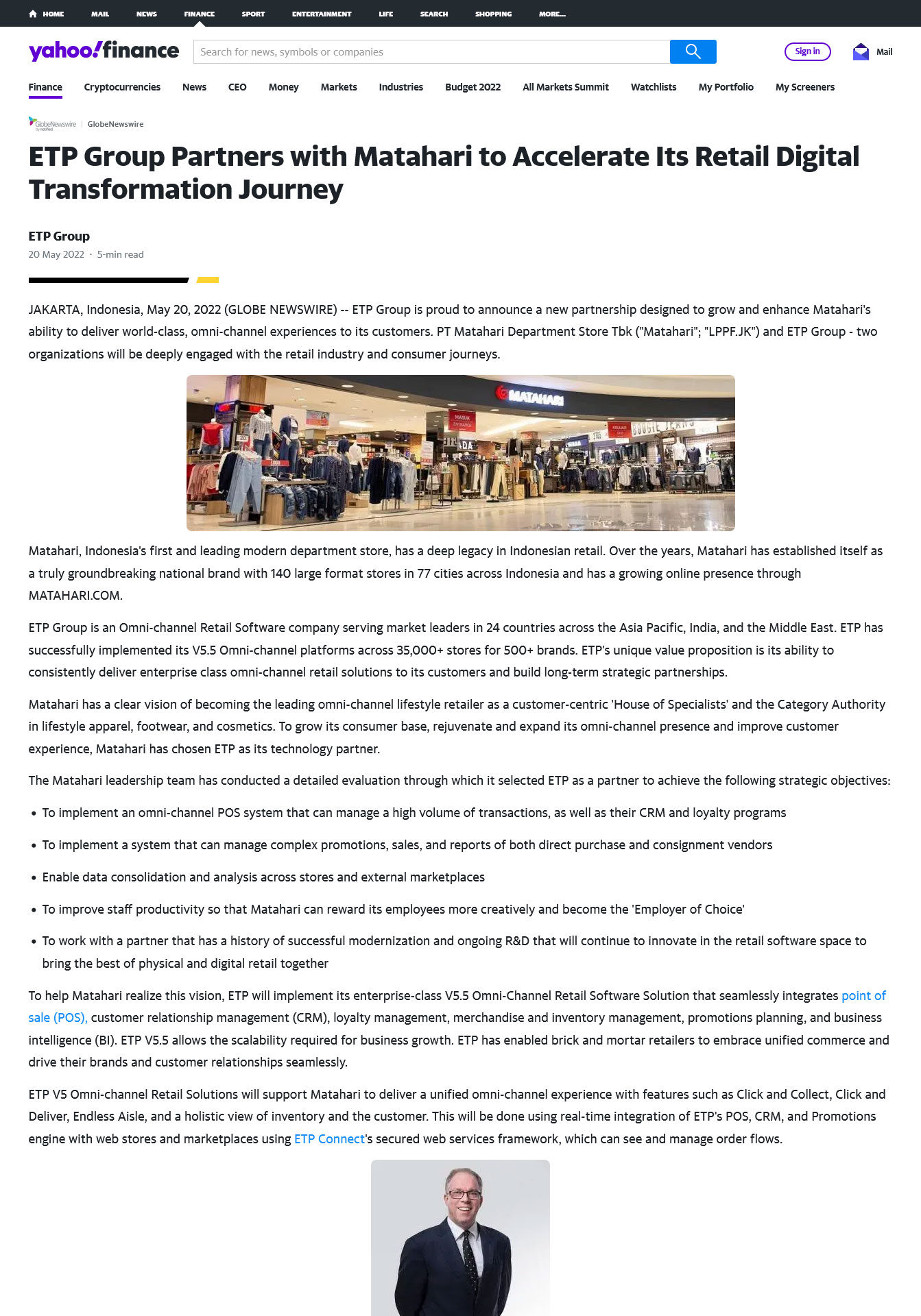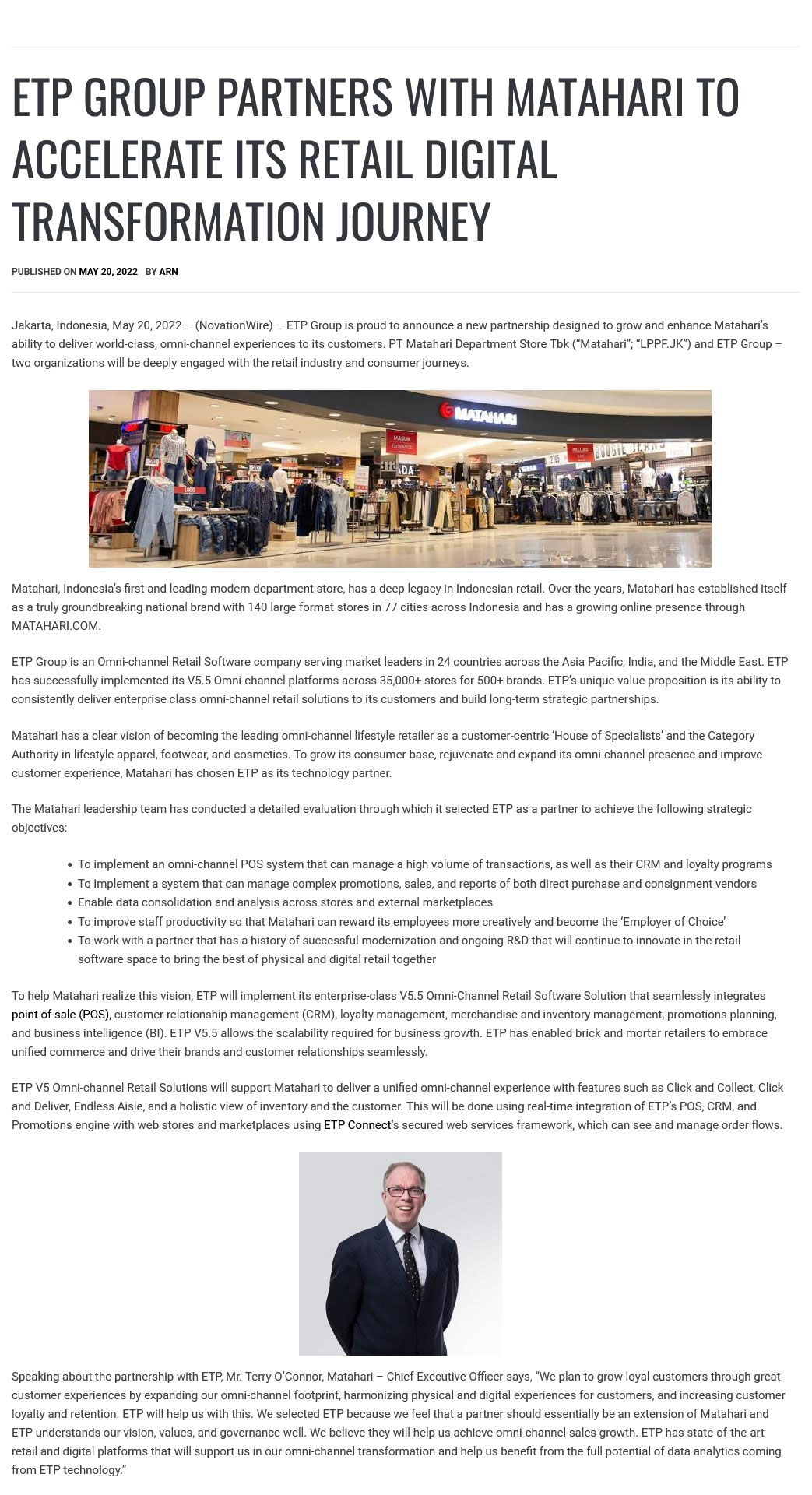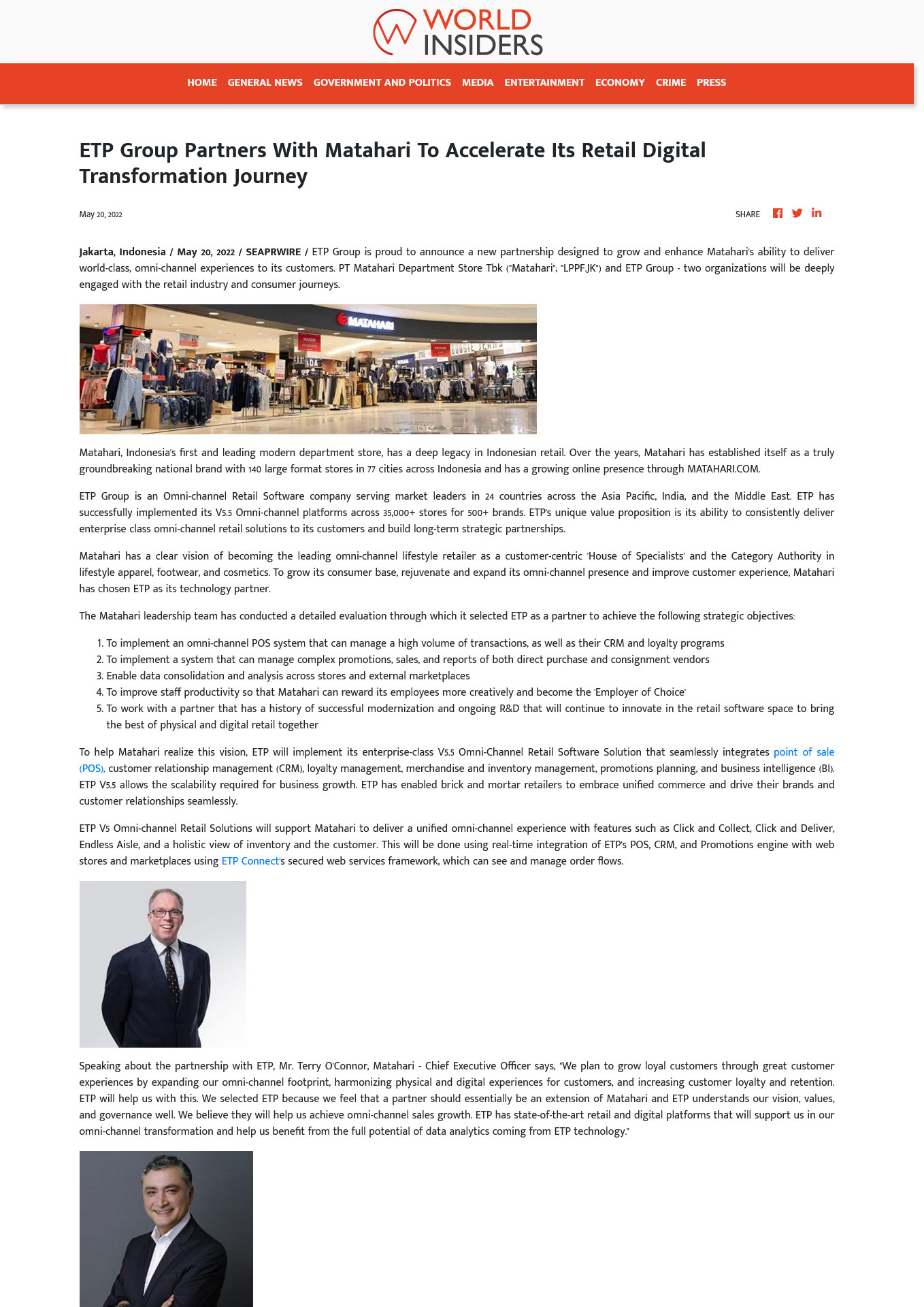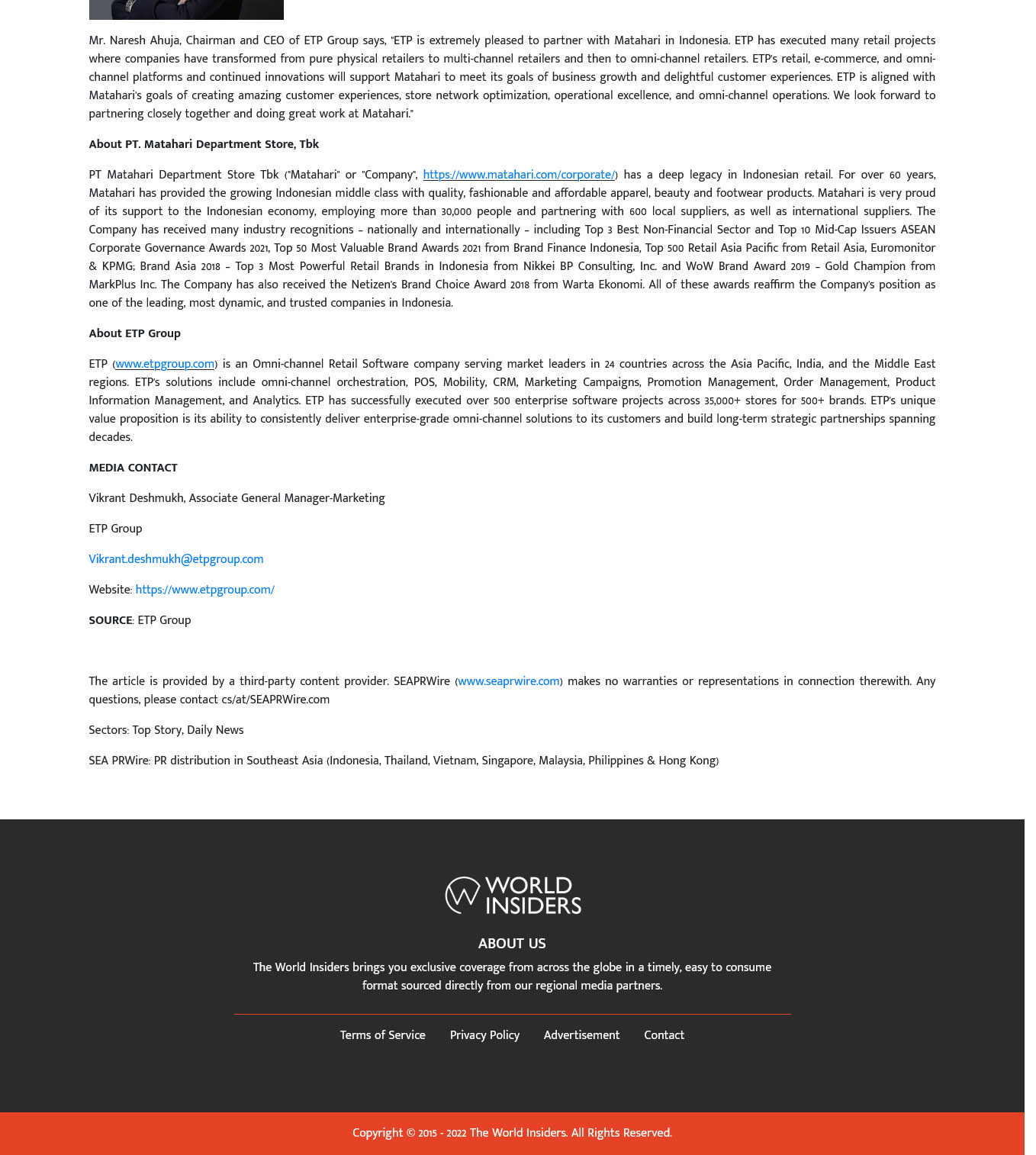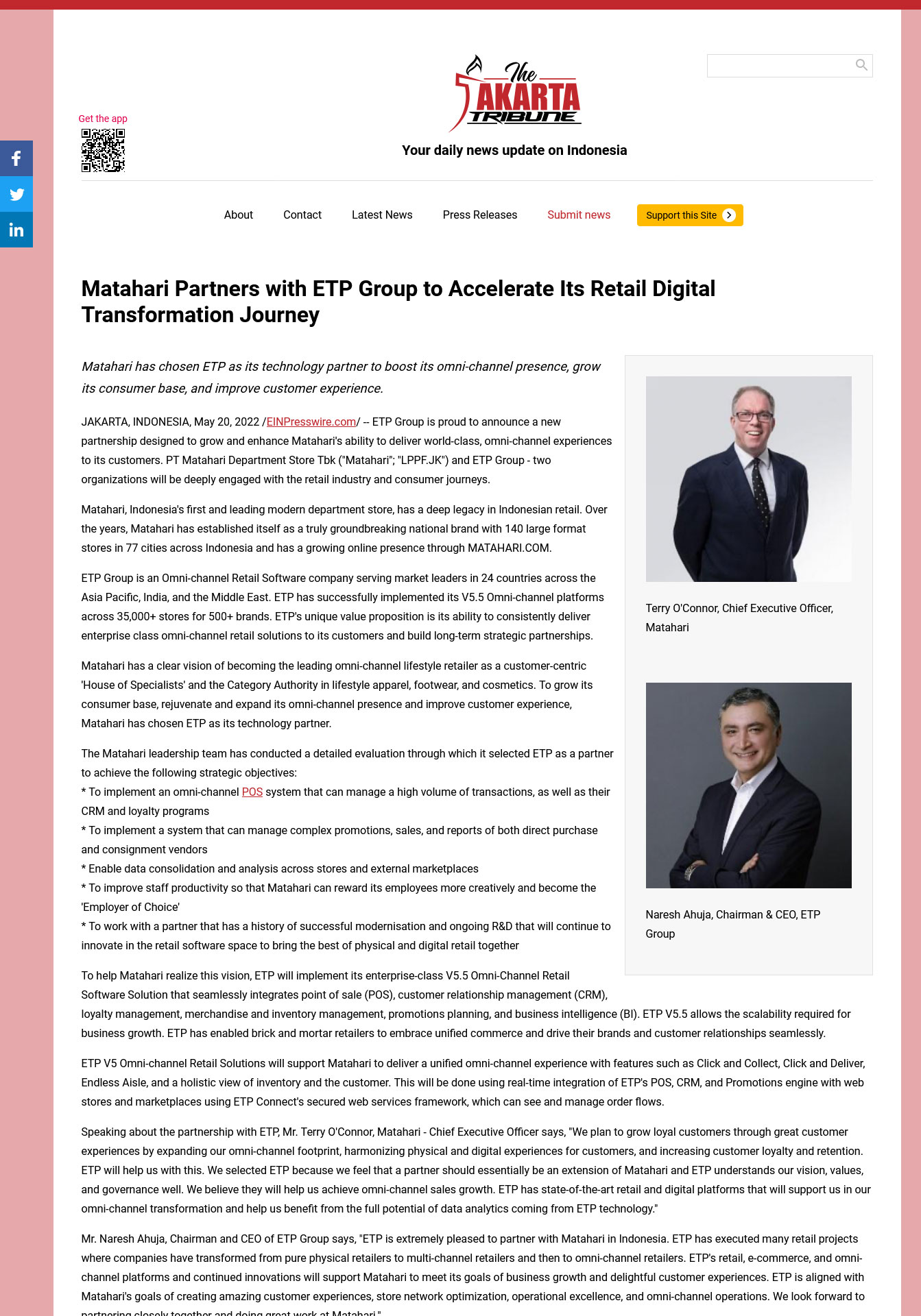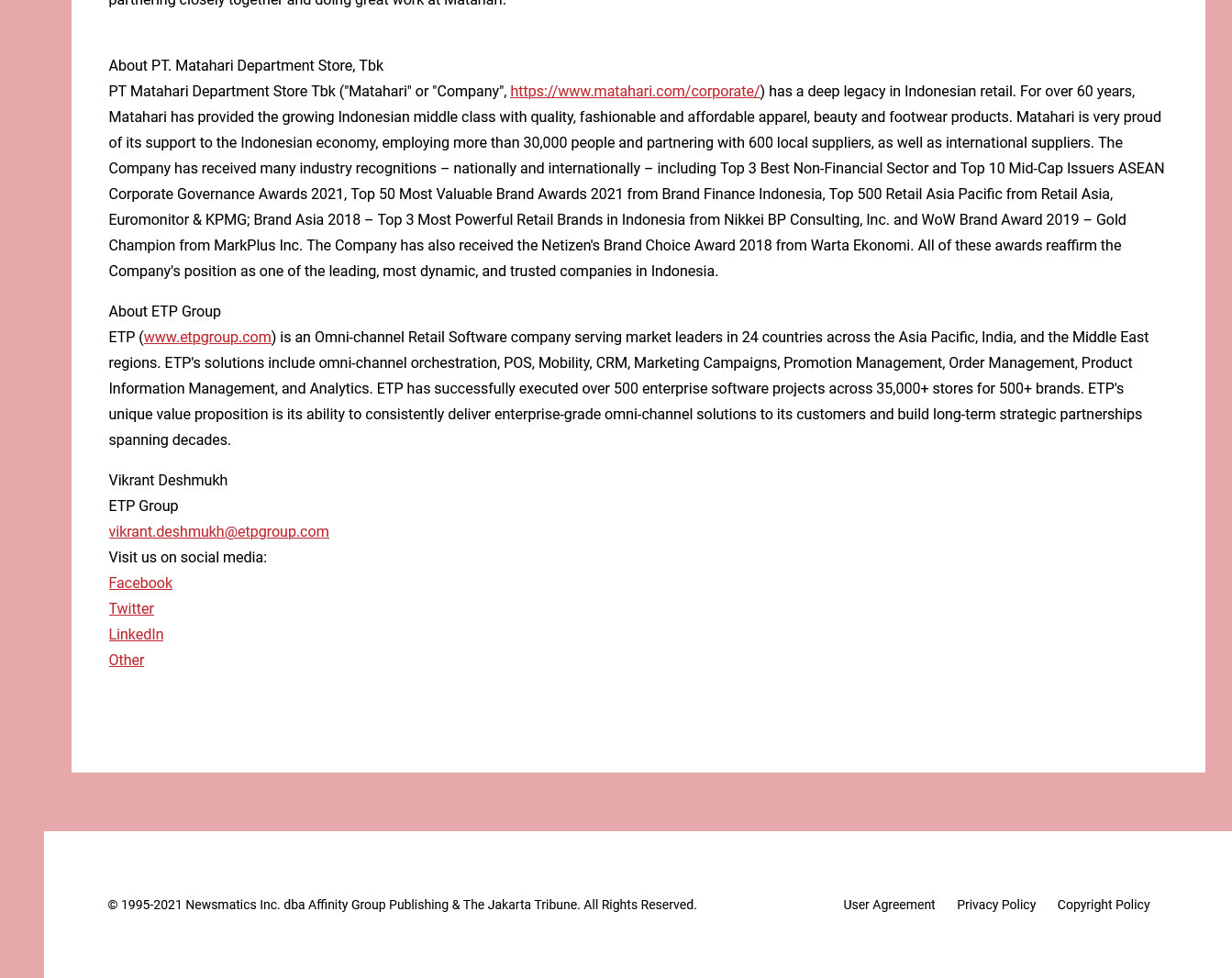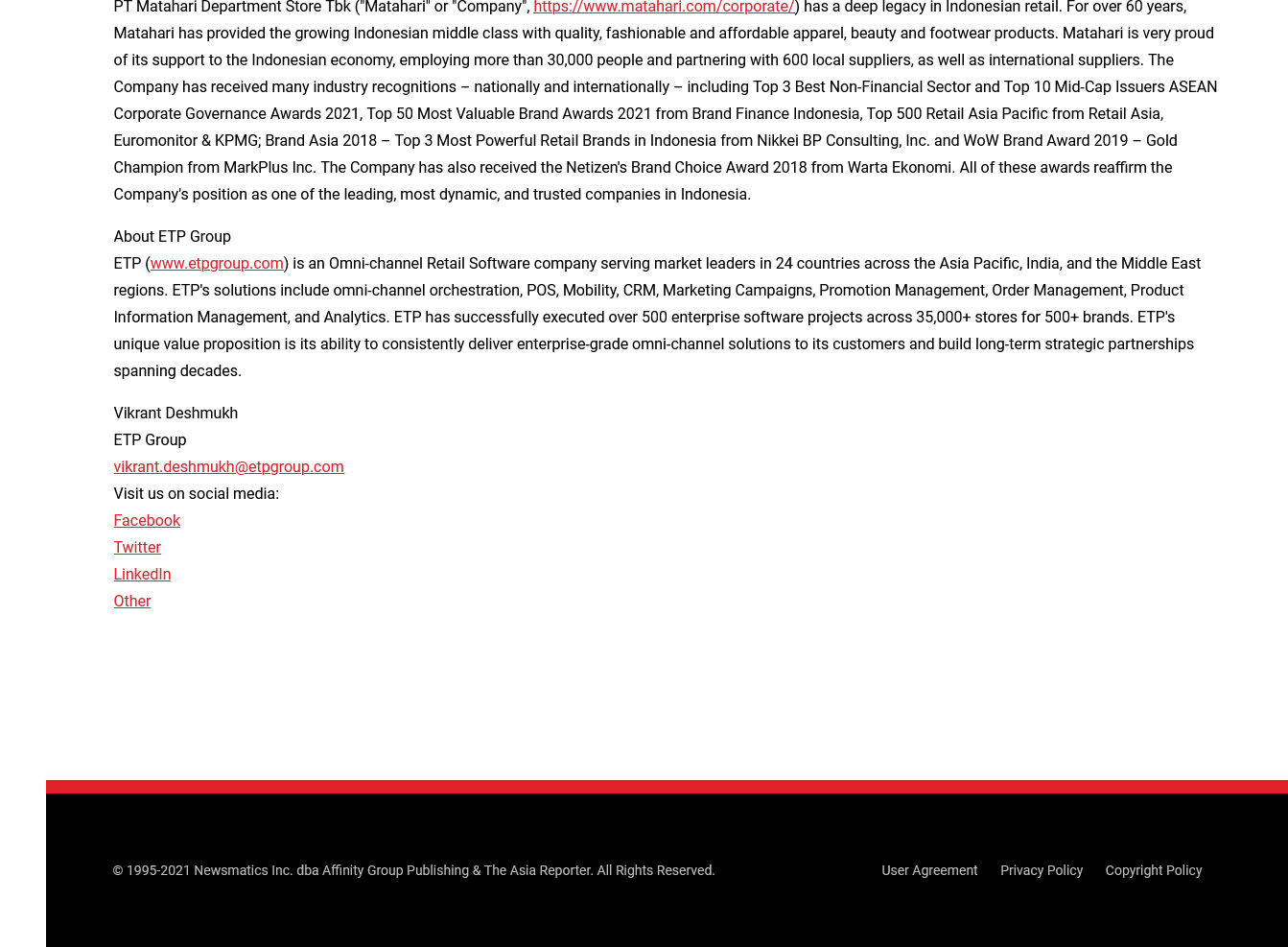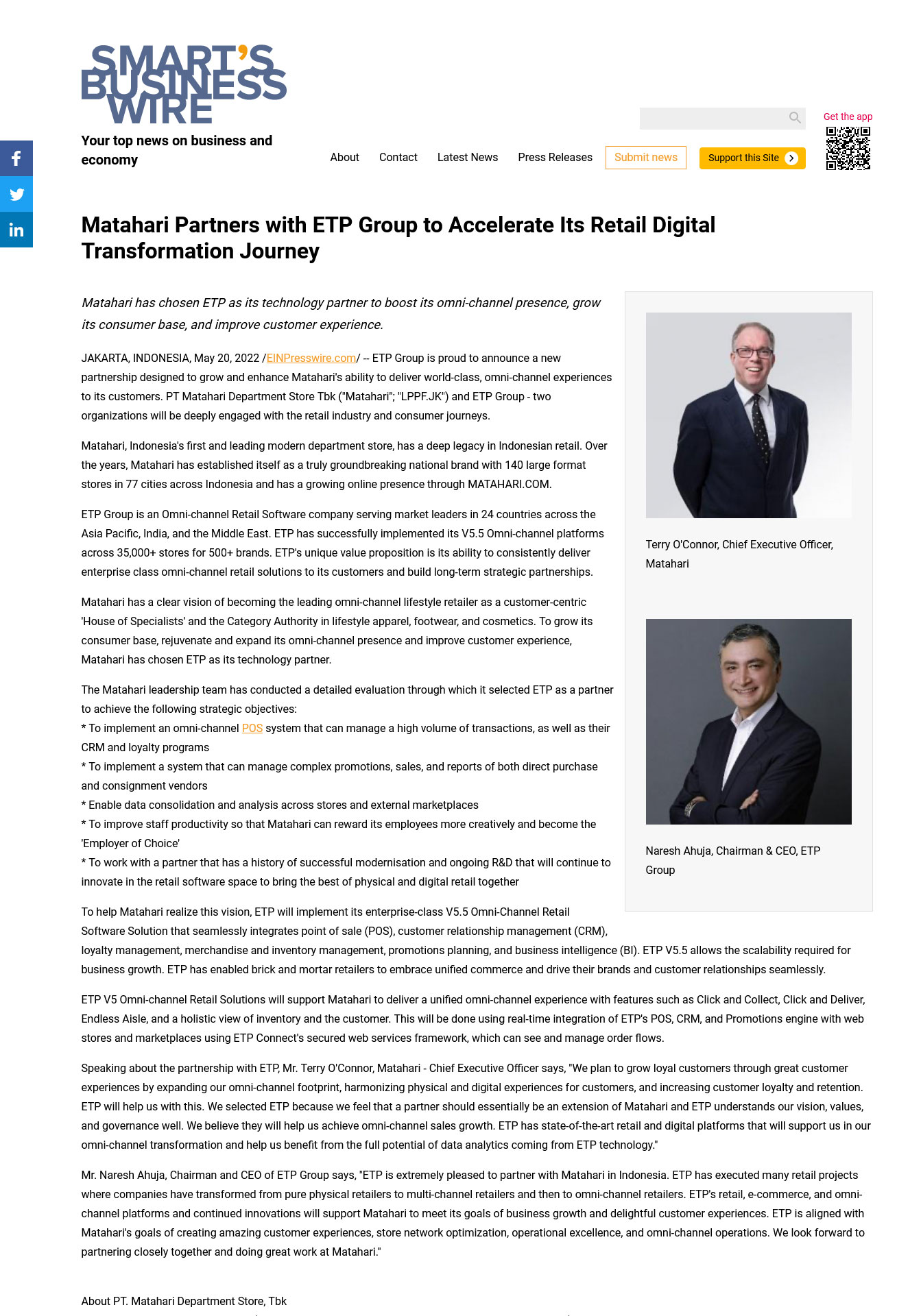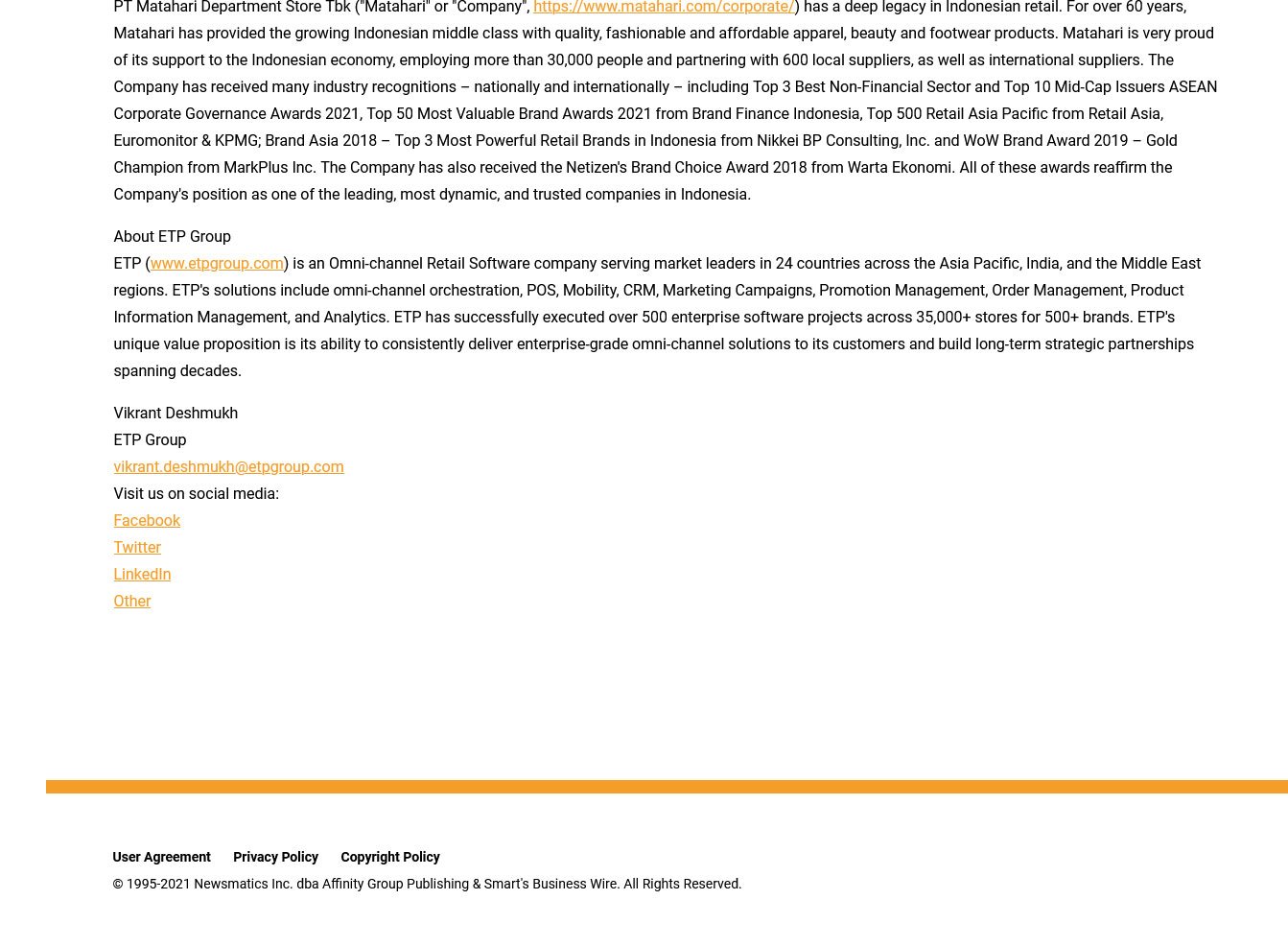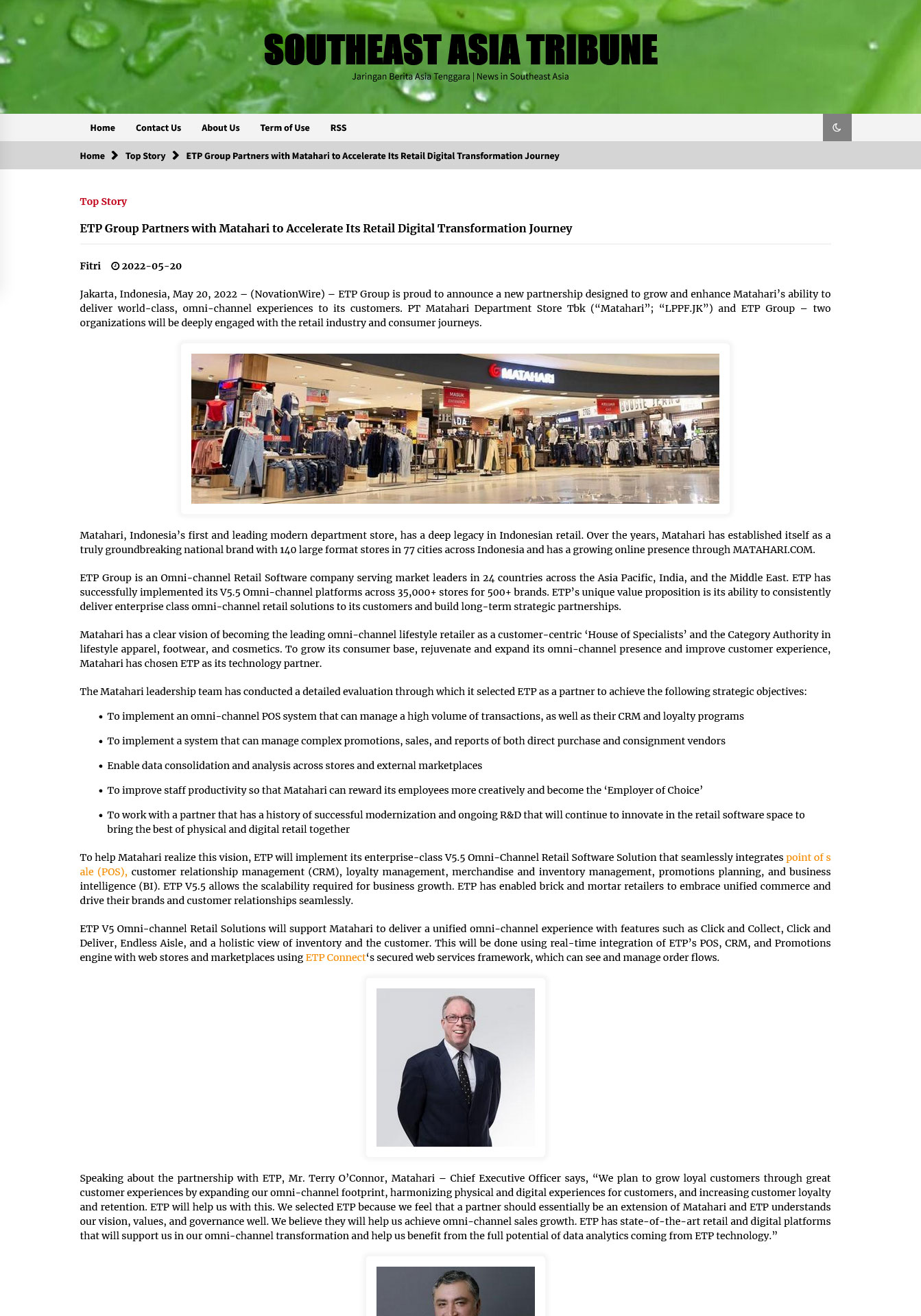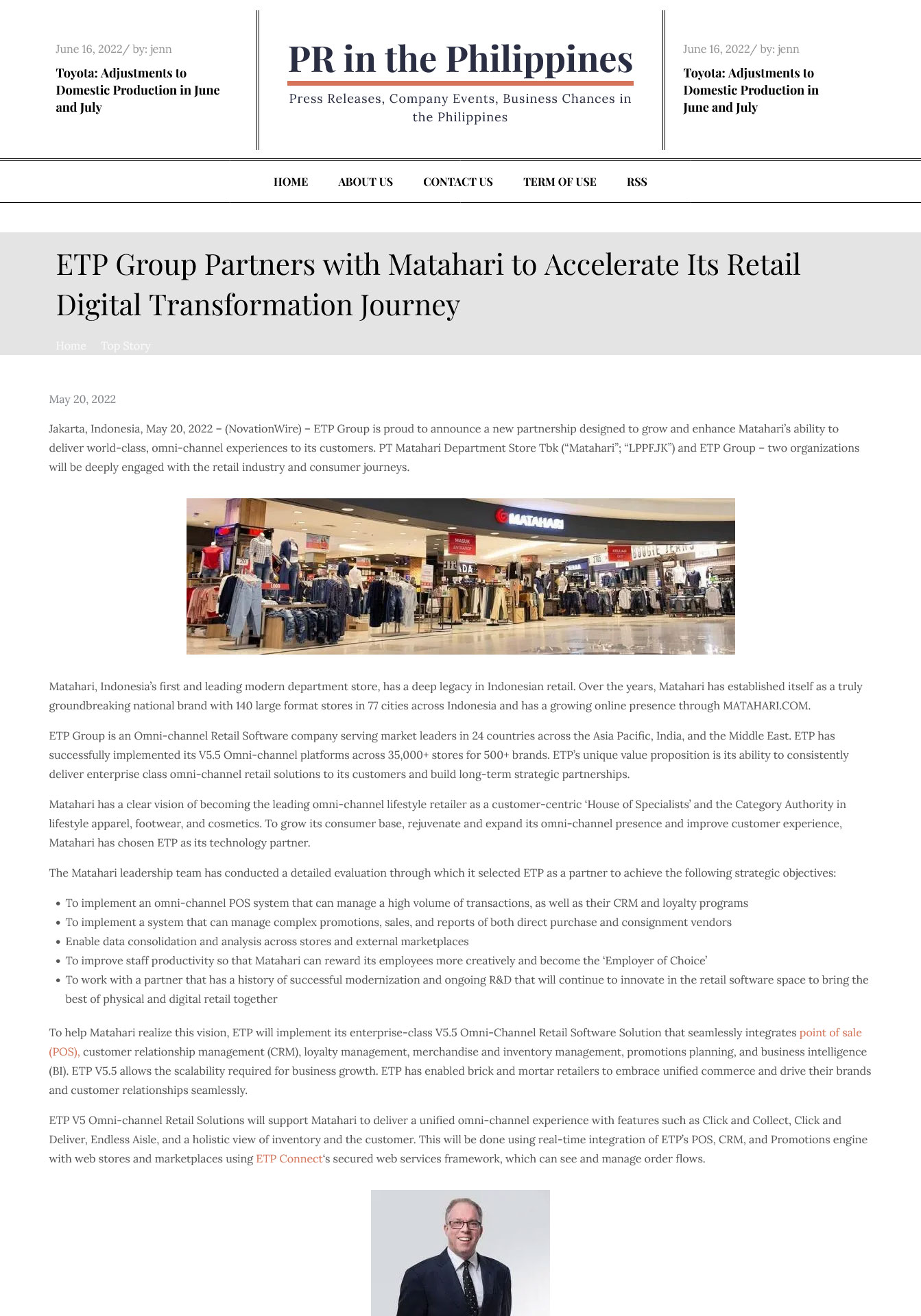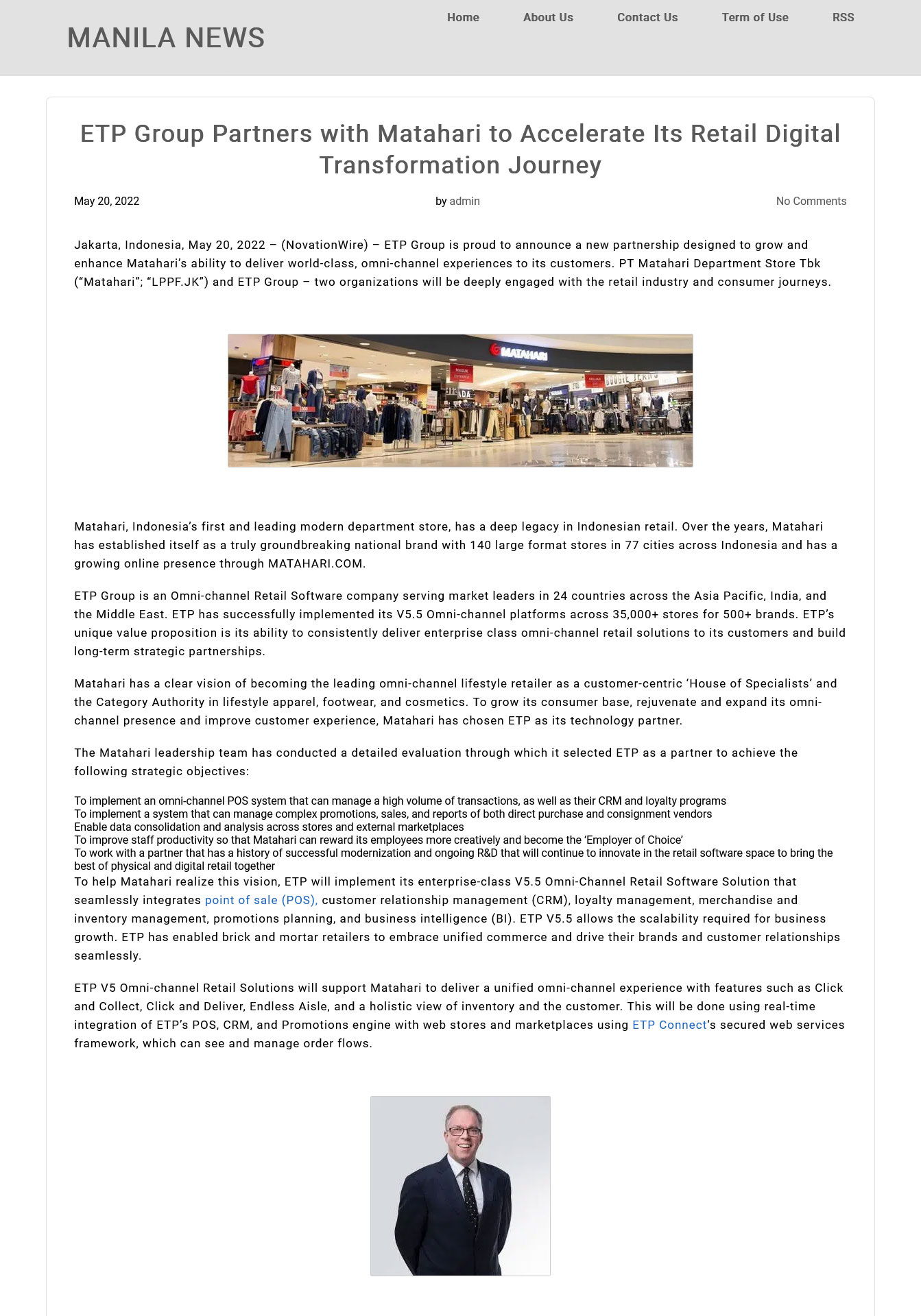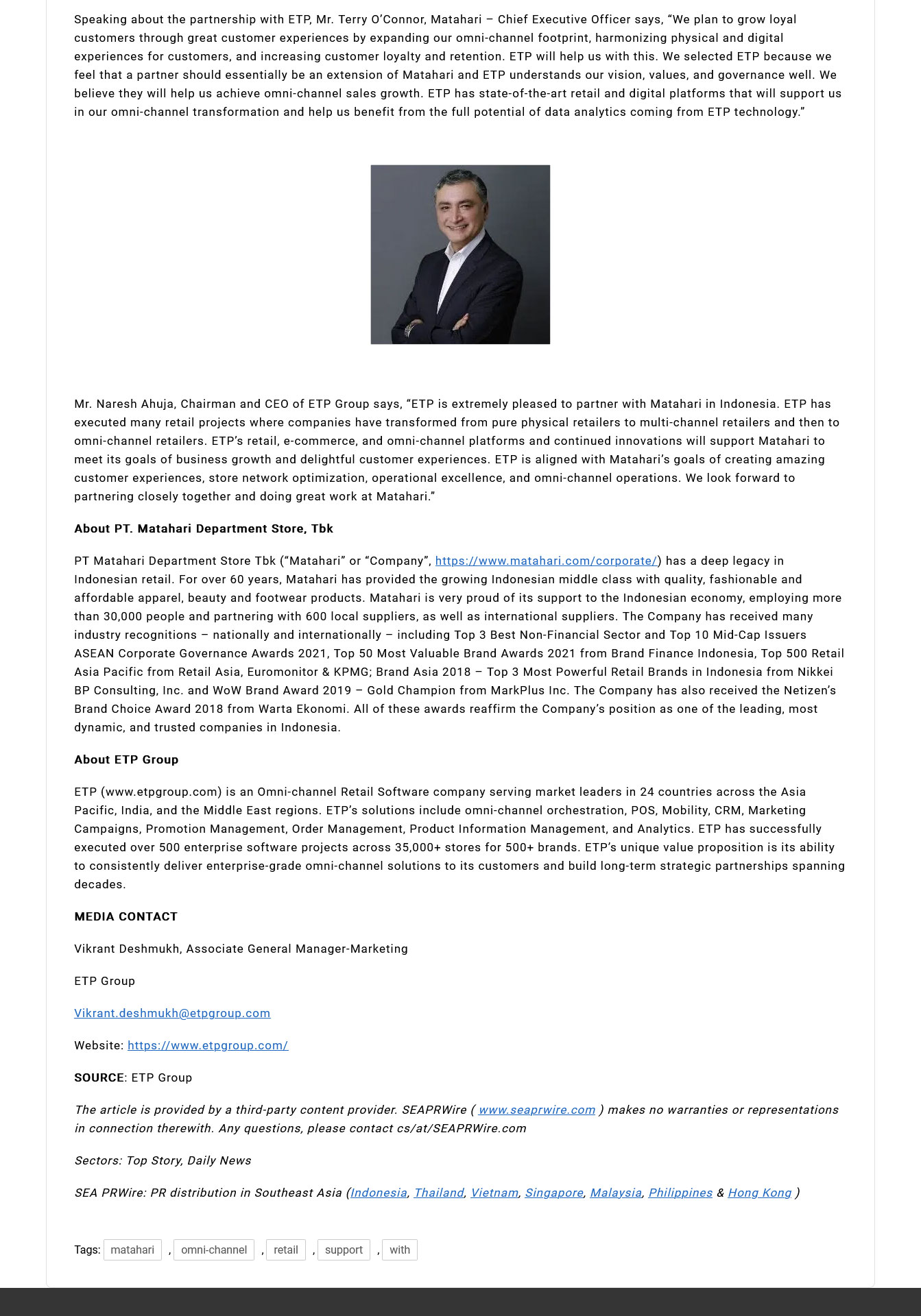
ETP Group Bekerjasama dengan Matahari dalam percepatan Perjalanan Transformasi Digital Ritelnya
ETP proudly announces a new win: Jakarta, Indonesia, 16th May 2022
ETP Group dengan bangga mengumumkan kerjasama baru yang bertujuan untuk membantu serta meningkatkan kemampuan Matahari dalam menghadirkan pengalaman omni-channel kelas dunia kepada pelanggannya. PT Matahari Department Store Tbk (“Matahari”; “LPPF.JK”) dan ETP Group akan menjalin kerjasama yang mendalam dengan fokus terhadap industri ritel serta pengalaman interaksi konsumen.
Matahari, department store modern pertama dan terkemuka di Indonesia, memiliki sejarah yang panjang dalam dunia ritel Indonesia. Selama bertahun-tahun, Matahari telah memantapkan dirinya sebagai merek nasional yang benar-benar inovatif dengan 140 toko berformasi besar di 77 kota di seluruh Indonesia dan hadir secara online melalui MATAHARI.COM yang senantiasa berkembang.
ETP Group adalah perusahaan Piranti Lunak Ritel Omni-channel yang melayani para pemimpin pasar di 24 negara di Asia Pasifik, India, dan Timur Tengah. ETP telah berhasil mengimplementasikan platform Omni-channel V5.5 di 35.000+ toko untuk 500+ merek. Nilai unik manfaat layanan ETP adalah kemampuannya yang secara konsisten melayani solusi ritel omni-channel kelas bisnis kepada pelanggannya dan membangun kerjasama strategis jangka panjang.
Matahari memiliki visi yang jelas untuk menjadi pemain ritel gaya hidup omni-channel terkemuka sebagai ‘House of Specialists’ yang berpusat pada pelanggan dan ‘Category Authority’ untuk gaya hidup mencakup produk pakaian, alas kaki dan kosmetik. Untuk menumbuhkan basis konsumen, meremajakan dan memperluas keberadaan omni-channel serta meningkatkan pengalaman pelanggannya, Matahari telah memilih ETP sebagai mitra teknologinya.
 Berbicara tentang kemitraan dengan ETP, Mr. Terry O’Connor, Matahari – Chief Executive Officer mengatakan, “Kami berencana untuk menumbuhkan loyalitas pelanggan melalui pengalaman pelanggan yang luar biasa dengan cara memperluas jejak omni-channel kami, menyelaraskan pengalaman fisik dan digital bagi pelanggan, dan meningkatkan loyalitas dan retensi pelanggan. ETP akan membantu kami dalam hal ini. Kami memilih ETP karena kami merasa bahwa mitra pada dasarnya merupakan perpanjangan tangan dari Matahari dan ETP memahami visi, nilai, dan tata kelola kami dengan baik. Kami yakin mereka akan membantu kami mencapai pertumbuhan penjualan omni-channel. ETP memiliki platform ritel dan digital tercanggih yang akan mendukung kami dalam transformasi omni-channel dan membantu kami sepenuhnya memanfaatkan potensi analisis data yang berasal dari teknologi ETP.”
Berbicara tentang kemitraan dengan ETP, Mr. Terry O’Connor, Matahari – Chief Executive Officer mengatakan, “Kami berencana untuk menumbuhkan loyalitas pelanggan melalui pengalaman pelanggan yang luar biasa dengan cara memperluas jejak omni-channel kami, menyelaraskan pengalaman fisik dan digital bagi pelanggan, dan meningkatkan loyalitas dan retensi pelanggan. ETP akan membantu kami dalam hal ini. Kami memilih ETP karena kami merasa bahwa mitra pada dasarnya merupakan perpanjangan tangan dari Matahari dan ETP memahami visi, nilai, dan tata kelola kami dengan baik. Kami yakin mereka akan membantu kami mencapai pertumbuhan penjualan omni-channel. ETP memiliki platform ritel dan digital tercanggih yang akan mendukung kami dalam transformasi omni-channel dan membantu kami sepenuhnya memanfaatkan potensi analisis data yang berasal dari teknologi ETP.”
 Mr. Naresh Ahuja, Pimpinan dan CEO ETP Group mengatakan, “ETP sangat senang bermitra dengan Matahari di Indonesia. ETP telah mengeksekusi banyak proyek ritel di mana perusahaan telah bertransformasi dari pengecer toko fisik semata menjadi pengecer multi-channel dan kemudian sebagai pengecer omni-channel. Platform ritel, e-commerce, dan omni-channel serta inovasi yang berkelanjutan dari ETP akan mendukung Matahari untuk memenuhi target pertumbuhan bisnis dan pengalaman pelanggan yang menyenangkan. ETP selaras dengan tujuan Matahari dalam menciptakan pengalaman pelanggan yang luar biasa, optimalisasi jaringan toko, keunggulan operasional, dan operasi omni-channel. Kami berharap dapat bekerja sama secara erat dan melakukan pekerjaan terbaik di Matahari.”
Mr. Naresh Ahuja, Pimpinan dan CEO ETP Group mengatakan, “ETP sangat senang bermitra dengan Matahari di Indonesia. ETP telah mengeksekusi banyak proyek ritel di mana perusahaan telah bertransformasi dari pengecer toko fisik semata menjadi pengecer multi-channel dan kemudian sebagai pengecer omni-channel. Platform ritel, e-commerce, dan omni-channel serta inovasi yang berkelanjutan dari ETP akan mendukung Matahari untuk memenuhi target pertumbuhan bisnis dan pengalaman pelanggan yang menyenangkan. ETP selaras dengan tujuan Matahari dalam menciptakan pengalaman pelanggan yang luar biasa, optimalisasi jaringan toko, keunggulan operasional, dan operasi omni-channel. Kami berharap dapat bekerja sama secara erat dan melakukan pekerjaan terbaik di Matahari.”
Tim kepemimpinan Matahari telah melakukan evaluasi terperinci sebelum akhirnya memilih ETP sebagai mitra untuk mencapai tujuan strategis berikut:
- Untuk menerapkan sistem POS omni-channel yang dapat mengelola transaksi dengan volume yang tinggi, dan juga terhadap program CRM dan loyalitas mereka
- Untuk menerapkan sistem yang dapat mengelola promosi , penjualan, dan laporan yang beragam baik untuk penjualan secara langsung maupun secara konsinyasi.
- Memungkinkan data konsolidasi dan analisis di seluruh toko dan lokapasar eksternal
- Meningkatkan produktifitas karyawan sehingga Matahari dapat memberikan penghargaan yang lebih kreatif kepada karyawannya dan menjadi ‘Employer of Choice’
- Bekerjasama dengan mitra yang memiliki sejarah keberhasilan terkait modernisasi dan pengembangan (R&D) berkelanjutan yang akan terus berinovasi di bidang piranti lunak ritel untuk menyajikan hasil terbaik dari kombinasi ritel fisik dan digital.
Untuk membantu Matahari mewujudkan visi ini, ETP mengimplementasikan Solusi Piranti Lunak Ritel Omni-Channel V5.5 kelas korporasi yang secara mulus mengintegrasikan POS, CRM, Manajemen Loyalitas, barang dagangan dan persediaan, perencanaan promosi serta BI (Business Intelligence). ETP V5.5 memungkinkan skalabilitas yang diperlukan untuk pertumbuhan bisnis. ETP memungkinkan peritel dengan toko fisik dalam menerapkan ”Unified Commerce” dan menggerakkan merek serta hubungan dengan pelanggan dengan lancar.
ETP V5 Omni-channel Retail Solutions akan mendukung Matahari untuk menghadirkan pengalaman omni-channel terpadu dengan fitur-fitur seperti Click and Collect, Click and Deliver, Endless Aisle, dan pandangan menyeluruh terhadap persediaan barang serta pelanggan. Hal ini akan dilakukan menggunakan integrasi real-time dari mesin POS, CRM, dan Promosi ETP dengan toko online dan lokapasar menggunakan kerangka web service yang aman dari ETP Connect, yang dapat menampilkan dan mengelola pesanan.
Tentang ETP Group
ETP (www.etpgroup.com) adalah perusahaan Piranti Lunak Ritel Omni-channel yang melayani pemimpin pasar di 24 negara di kawasan Asia Pasifik, India, dan Timur Tengah. Solusi ETP mencakup orkestrasi omni-channel, POS, Mobile POS, CRM, Kampanye Pemasaran, Manajemen Promosi, Manajemen Order, Manajemen Informasi Produk, dan Analisis. ETP telah berhasil mengeksekusi lebih dari 500 proyek implementasi piranti lunak korporasi di 35.000+ toko untuk 500+ merek. Proposisi keunikan nilai ETP adalah kemampuannya untuk secara konsisten memberikan solusi omni-channel tingkat korporasi kepada pelanggannya dan membangun kemitraan strategis jangka panjang yang mencakup beberapa dekade.
Tentang PT. Matahari Department Store, Tbk
PT. Matahari Department Store, Tbk (“Matahari” atau “Perseroan”, https://www.matahari.com/corporate/) memiliki sejarah yang panjang dalam dunia ritel indonesia. Selama lebih dari 60 tahun, Matahari menyediakan produk pakaian, kecantikan dan sepatu yang berkualitas, fashionable dan terjangkau bagi kalangan menengah Indonesia yang semakin meningkat.
Matahari sangat bangga dapat melayani perekonomian Indonesia, mempekerjakan lebih dari 30,000 orang dan bekerjasama dengan 600 pemasok baik lokal maupun internasional. Perseroan telah menerima beberapa penghargaan dari industri – bertaraf nasional dan internasional – termasuk Top 3 Best Non-Financial Sector dan Top 10 Mid-Cap Issuers ASEAN Corporate Governance Awards 2021, Top 500 Retail Asia Pacific dari Retail Asia, Euromonitor & KPMG; Brand Asia 2018 – Top 3 Most Powerful Retail Brands in Indonesia dari Nikkei BP Consulting, Inc.; dan WoW Brand Award 2019 – Gold Champion dari MarkPlus Inc. Di samping itu, Perseroan juga meraih penghargaan Indonesia Netizen’s Brand Choice Award 2018 dari Warta Ekonomi. Seluruh penghargaan ini mendukung dan memperkuat reputasi Perseroan sebagai salah satu perusahaan yang terkemuka, dinamis, dan tepercaya di Indonesia .



